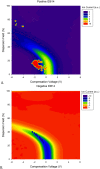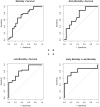Prediction of mortality in severe acute malnutrition in hospitalized children by faecal volatile organic compound analysis: proof of concept
- PMID: 33154417
- PMCID: PMC7645771
- DOI: 10.1038/s41598-020-75515-6
Prediction of mortality in severe acute malnutrition in hospitalized children by faecal volatile organic compound analysis: proof of concept
Erratum in
-
Author Correction: Prediction of mortality in severe acute malnutrition in hospitalized children by faecal volatile organic compound analysis: proof of concept.Sci Rep. 2021 Feb 3;11(1):3390. doi: 10.1038/s41598-021-83012-7. Sci Rep. 2021. PMID: 33536568 Free PMC article. No abstract available.
Abstract
Children with severe acute malnutrition (SAM) display immature, altered gut microbiota and have a high mortality risk. Faecal volatile organic compounds (VOCs) reflect the microbiota composition and may provide insight into metabolic dysfunction that occurs in SAM. Here we determine whether analysis of faecal VOCs could identify children with SAM with increased risk of mortality. VOC profiles from children who died within six days following admission were compared to those who were discharged alive using machine learning algorithms. VOC profiles of children who died could be separated from those who were discharged with fair accuracy (AUC) = 0.71; 95% CI 0.59-0.87; P = 0.004). We present the first study showing differences in faecal VOC profiles between children with SAM who survived and those who died. VOC analysis holds potential to help discover metabolic pathways within the intestinal microbiome with causal association with mortality and target treatments in children with SAM.Trial Registration: The F75 study is registered at clinicaltrials.gov/ct2/show/NCT02246296.
Conflict of interest statement
The authors declare no competing interests.
Figures


References
-
- UNICEF . Levels and Trends in Child Mortality. New York: UNICEF; 2015.
-
- WHO . Guideline: Updates on the Management of Severe Acute Malnutrition in Infants and Children. Geneva: WHO; 2013. - PubMed
Publication types
MeSH terms
Substances
Associated data
LinkOut - more resources
Full Text Sources
Medical

